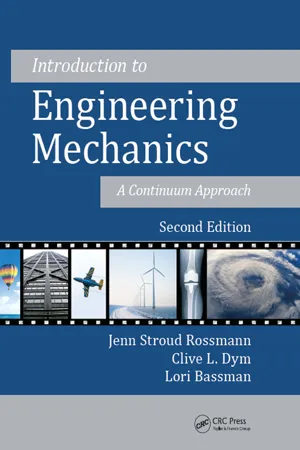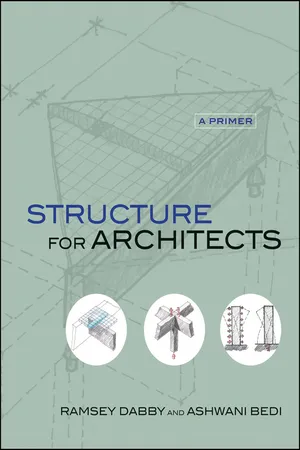Technology & Engineering
Principal Strain
Principal strain refers to the maximum and minimum strains experienced by an object in a specific direction due to an applied load. It is a measure of the deformation of a material and is used to analyze the behavior of structures under stress. By understanding the principal strains, engineers can design and optimize materials to withstand various types of loads and forces.
Written by Perlego with AI-assistance
Related key terms
Related key terms
1 of 4
Related key terms
1 of 3
7 Key excerpts on "Principal Strain"
- eBook - ePub
Design-Tech
Building Science for Architects
- Thomas Leslie, Robert Whitehead(Authors)
- 2014(Publication Date)
- Routledge(Publisher)
r = 0.658″ or approx. 5/8″Designers can use this information to evaluate the ramifications on the sizing and spacing of support elements if any of the design factors were to change. For instance, because the load and component size (area) are directly proportional, if the spacing of the cables were to double (thereby doubling the tributary area), the area of the cable would also have to double (although because it is a circle, doubling the area doesn't double the radius).However, in these examples we are only evaluating an element based on its capacity to carry a load, in other words, its strength. Under stress, each element will also deform, and so the relative value of a material's stiffness also needs to be evaluated.Stresses and Strains
Loads cause stress (tension, compression, bending or torsion) and stresses deform or strain supporting members. In the simplest terms, stress is what is felt, strain is what happens as a result. Different types of stress cause different types of deformations to occur. Initially we will focus on the strains caused by the axial stresses of tension and compression. If an object is pulled or pushed under loading it changes from its original shape by becoming shorter or longer—these strains are often too small to see, but the change does occur.Simply put, strain, s, is a measure of an object's change in length (defection), e, compared to its original length, L, as described in the equation.s = e / LIn 1678, Robert Hooke, an associate of London architect Christopher Wren, discovered two key laws of structural behavior related to stress and strain.First, he found that the strain of a material is always proportional to the stress it undergoes, or in Hooke's words, “Ut tensio, sic vis” (“As the elongation, so is the force”). This means that doubling the force on a given structural member will double its deformation (Figure 21.4 - eBook - ePub
Structure for Architects
A Case Study in Steel, Wood, and Reinforced Concrete Design
- Ashwani Bedi, Ramsey Dabby(Authors)
- 2019(Publication Date)
- Routledge(Publisher)
3 Stress, Strain, and Material Behavior3.1 Stress, Strain, and Material Properties
Many of a material’s structural properties are defined by their behavior under stress. A good understanding of these properties is needed to properly design for them.Stress
If we apply an axial tensile or compressive force (P) on a material having a length (L) and a cross-sectional area (A) (Figure 3.1 ), the uniform stress (F) in the material in tension or compression is given by:F = P/AFigure 3.1 Stress in a MaterialStrain
Under the applied load, the material will deform—i.e., it will elongate under tension, or shorten under compression (ΔL) (Figure 3.2 ). The amount of deformation divided by the original length is known as strain and is given by:STRAIN = ΔL/LFigure 3.2 Strain in a MaterialStress-Strain Curves
A stress-strain curve is a plot of stress (along the vertical axis) vs. strain (along the horizontal axis) that helps to visualize important behavioral characteristics of a material under load (Figure 3.3 ). Every material has a unique stress-strain curve, in tension as well as in compression.In a sense, a stress-strain curve can be considered a material’s ‘signature’ behavior under load.Figure 3.3 Axes of a Stress-Strain CurveMaterial Strength
Material strength is the ability of a material to withstand applied loads. Loads on a member cause various internal stresses that tend to produce deformations in its material. Depending on the type of load (transverse, axial, or torsional), the member may experience compression, tension, shear, or a combination of these stresses.- Steel’s material strength is represented by various values, most importantly its yield stress (Fy ).
- Wood’s material strength is dependent upon several different criteria such as the direction of force, the direction of grain, and its species and grade. Wood’s material strength is represented by values for bending stress (Fb ), tensile strength parallel to the grain (Ft ), compressive strength parallel to the grain (Fc ), compressive strength perpendicular the grain (Fc⊥ ), and shear strength parallel to the grain (Fv
- eBook - ePub
Introduction to Engineering Mechanics
A Continuum Approach, Second Edition
- Jenn Stroud Rossmann, Clive L. Dym, Lori Bassman(Authors)
- 2015(Publication Date)
- CRC Press(Publisher)
In some materials (e.g., rubber), small loads produce relatively large deformations. Other engineering materials, such as steel, undergo smaller deformations; however, it is still important to consider the effects of such changes. Even very rigid materials, when subjected to a load, will experience a small deformation. Instead of characterizing a material’s behavior in terms of loads and deformations, we will do so in terms of stresses and strains, defining the material’s constitutive law. For most engineering materials, a simple relationship exists between stress and strain. For each increment in stress, there is a proportional increase in strain, provided that a certain limit of stress is not exceeded. If the induced stress exceeds the limiting value, the strain will no longer be linearly proportional to the stress. This limiting value is called the proportional limit. Most of the behavior we will consider occurs below the proportional limit, in the regime where stress and strain enjoy a linearly proportional relationship. If we subject a material in this regime to a tensile load P A, producing a stress σ A and a strain ε A, then subject it to a tensile load P B, producing a stress σ B and a strain ε B, and then we plot the stresses and strains to see a linear relationship between stress and strain, as shown in Figure 2.11. * This linear relationship between load and deformation was first stated by Robert Hooke in 1678, and became known as Hooke’s law : Ut tensio, sic vis. This Latin phrase—in the form of an anagram, ceiiinosssttuv —was how Robert Hooke * summed up his finding, which he first applied to the extension of a spring - eBook - ePub
- Jack Hu, Zdzislaw Marciniak, John Duncan(Authors)
- 2002(Publication Date)
- Butterworth-Heinemann(Publisher)
tension , will be used even though this suffers from the disadvantage that the force is not always a tensile force. If the tension is negative, it indicates a compressive force. This is not a serious problem as in plane stress sheet forming, almost without exception, one tension will be positive, i.e. the sheet is always pulled in one direction. It is impractical to form sheet by pushing on the edge; the expression used by practical sheet formers is that ‘you cannot push on the end of a rope’.In the convention used here, the principal direction 1 is that in which the principal stress has the greatest (most positive) value, and the major tension T1 = σ1 t will always be positive. In stretching processes, the minor tension T2 = σ2 t is tensile or positive. In other processes, the minor tension could be compressive and in some cases the thickness will increase. If T 2 is compressive and large in magnitude, wrinkling may be a problem.In discussing true stress in Section 1.1.3 , it was shown that for most real materials, strain-hardening continues, although at a diminishing rate, and true stress does not reach a maximum. As tension includes thickness, which in many processes will diminish, T may reach a maximum; this limits the sheet’s ability to transmit load and is one of the reasons for considering tension in any analysis.3.2 Strain distributions
In the study of any process, we usually determine first the strain over the part. This can be done by measuring a grid as in Figure 3.1 , or by analysis of the geometric constraint exerted on the part. An example is the deep drawing process in Figure 3.2(a) and in the Introduction, Figure I.9 . As the process is symmetric about the axis, we need only consider the strain at points on a line as shown in Figure 3.2(b) . Plotting these strains in the Principal Strain space, Figure 3.2(c) - eBook - ePub
Analysis of Structures
An Introduction Including Numerical Methods
- Joe G. Eisley, Antony M. Waas(Authors)
- 2011(Publication Date)
- Wiley(Publisher)
9.6.13 .(9.6.13)Since this is a set of homogenous equations we can only solve for two of the direction cosines in terms of the third. The third one is found from the property of direction cosines that(9.6.14)The software products, such as Mathematica, Maple, Matlab, and Mathcad, among others have eigenvalue solvers for exactly this form of the equations. Example 9.6.1Problem: Find the principal normal stresses and the maximum shear stress at a point in the three dimensional solid where the stresses are(a)Solution: Use Equation 9.6.13With the stress values inserted the eigenvalue equations become(b)The three eigenvalues, or principal stresses, are(c)The eigenvector, or orientation of the principal stresses, is found by inserting one of the principal stresses into Equation (a) and solving for(d)Each column presents the eigenvectors or direction cosines for the corresponding principal stress. 9.7 Allowable and Ultimate Stress, and Factors of SafetyUp to now we have limited the discussion to levels of stress and strain that do not exceed the linearly elastic range of the material. Most load bearing structures are designed so that the levels of stress and strain always remain in this linear range. The point at which higher values of stress causes the stress-strain curve to deviate from a straight line is called the proportional limit. We need to examine what happens when stress values exceed this limit. A generic stress-strain curve is shown as obtained from a uniaxial test in Figure 9.7.1 .Figure 9.7.1The point at which the curve is no longer elastic is called the yield stress - eBook - ePub
Practical Guide to the Packaging of Electronics
Thermal and Mechanical Design and Analysis, Third Edition
- Ali Jamnia(Author)
- 2016(Publication Date)
- CRC Press(Publisher)
When dealing with ductile materials, there are several points of interest on the strain–stress curve. Knowledge of these points enables us to verify whether a system has failed or has the potential of failure. These are defined as follows:- Proportional limit: The point on the stress–strain curve where the curve begins to deviate from a straight line.
- Elastic limit: Maximum stress to which a specimen may be subjected when, upon removal of the load, no permanent deformation is caused.
- Yield point: A point on the curve where there is a sudden increase in strain without a corresponding increase in stress.
- Yield strength: The maximum stress that can be applied without permanent deformation of the test specimen. This is the value for which there is an elastic limit or at 2% deformation.
- Ultimate strength: Also called tensile strength, it is the maximum stress value obtained on a stress–strain curve.
Determining Deformations under Application of General Loads
The general equations of elasticity are formulated first by balancing the external forces with the internal stresses and obtaining the differential equations of equilibrium. The general form of these equations is as follows:+∂σ x∂ x+∂τx y∂ y+ X = 0∂τy z∂ z+∂σ y∂ x+∂τx y∂ y+ Y = 0∂τy z∂ z+∂σ z∂ x+∂τx y∂ y+ Z = 0∂τy z∂ zThe solution to these equations must satisfy not only the boundary conditions but also what is called the conditions of compatibility. These conditions are a set of six differential equations between various components of strain (Timoshenko and Goodier 1970). Once the stresses and strains are calculated, the overall deformations may be determined.Thermal Strains and Stresses
As electronics equipment is operated, the internal temperature rises to a steady-state value. Once the equipment is shut down, the temperature is lowered to that of the environment.There is also true temperature transience as electronics equipment is operated. Suppose that the electronics equipment is used for number crunching. As the CPU is engaged in this activity, its power consumption increases and there is a corresponding increase in temperature. As this activity is reduced for I/O activities, or once the calculations are completed, the power consumption is reduced, thereby reducing the temperature levels. - eBook - ePub
Structure for Architects
A Primer
- Ramsey Dabby, Ashwani Bedi(Authors)
- 2012(Publication Date)
- Wiley(Publisher)
When any particular material is stressed, its resulting strain behavior (i.e., deformational behavior) is unique, not only for that material but also for the type of stress (compression or tension) to which the material is subjected. Steel, for example, behaves similarly in compression as in tension, while concrete behaves quite differently in compression than in tension.A material's stress-strain relationship is graphically depicted in a stress-strain curve with stress plotted along the y axis and strain along the x axis. A stress-strain curve is, in a sense, a material's signature behavior under stress. Although any particular material's stress-strain curve is unique, materials generally exhibit some (or all) of the strain behavior patterns broadly characterized as elastic range, plastic range, and strain-hardening range prior to rupture, the point at which the material actually breaks. The stress-strain curve in Figure 13.3 is for a hypothetical ductile material, such as steel, in tension. Table 13.1 describes the general characteristics of the three strain ranges.Figure 13.3 Stress-Strain Curve for a Hypothetical Ductile Material in TensionTable 13.1 Elastic, Plastic, and Strain-Hardening Range CharacteristicsRange Characteristics Elastic Range In this range, a force applied to a material causes it to become stressed, resulting in deformation (strain). When the force is removed, the material returns to its original unstressed shape. Plastic Range In this range, with relatively little increase in stress, the material behaves somewhat taffy-like and becomes permanently deformed. Strain-Hardening Range In this range, the material stabilizes somewhat and is able to take on additional stress with a corresponding increase in deformation (strain) until it reaches its ultimate strength and ruptures. Stress-strain behavior for the variety of structural materials available is a complex field of study. The reader is referred to more technical sources for a detailed review of the topic. For a simplified comparison, however, the generalized stress-strain curves for steel, concrete (in compression), and wood are shown in Figure 13.4
Index pages curate the most relevant extracts from our library of academic textbooks. They’ve been created using an in-house natural language model (NLM), each adding context and meaning to key research topics.
Explore more topic indexes
Explore more topic indexes
1 of 6
Explore more topic indexes
1 of 4






